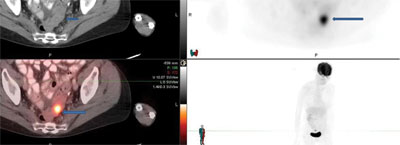The role of PET/CT in detection of occult recurrent ovarian cancer
A 63-year-old woman with no significant medical history was diagnosed with ovarian cancer in August 2011.
She started complaining of abdominal distension. Her initial ultrasound was suspicious for an adnexal mass. Thereafter, she underwent a subtotal debulking surgical resection with hysterectomy and bilateral salpingo-oophorectomy.
Her PET/CT scan in October showed a large amount of ascites with diffuse peritoneal carcinomatosis with a maximum standard uptake value (SUV) of 8.3. The liver had two ill-defined hypodense lesions in the right hepatic lobe measuring up to 0.6 cm in diameter that were focally hypermetabolic with maximum SUV of 2.7. There were few non-enlarged retroperitoneal lymph nodes that showed mild hypermetabolism with maximum SUV of 3.
She went on to receive chemotherapy with carboplatin and paclitaxel for six cycles. She tolerated the treatment well, with an excellent clinical response.

Figure 1. Clockwise from upper left: Axial CT, axial PET, fused axial PET-CT and maximal intensity projection demonstrate a hypermetabolic implant over the sigmoid colon, highly suggestive of recurrent ovarian carcinoma.
Source: Ghesani M
A PET/CT scan in February showed a marked decrease in size of all of the peritoneal nodules, with an interval resolution of their hypermetabolic activity. The previously hypermetabolic liver lesions were no longer identified and her ascites had resolved.
She completed her chemotherapy in April. She remained asymptomatic and her tumor marker, CA-125, also remained in the normal range. However, a repeat PET/CT scan in June showed interval development of hypermetabolic implant along the distal sigmoid colon, measuring approximately 2.8 cm × 1.9 cm, with maximum SUV of 11.2.

Figure 2. Clockwise from upper left: Axial CT, axial PET, fused axial PET-CT and maximal intensity projection 3 months later showed no evidence of metastatic implant in this region. The remainder of the scan showed significant improvement, consistent with positive response to therapy.
Source: Ghesani M
There was continuing decrease in volume of nodular soft tissue in the omental fat, peritoneal surfaces of the diaphragm, and along the falciform ligament, with interval resolution of associated hypermetabolism. There was no anatomical or functional evidence of any metastatic disease in liver or retroperitoneal lymph nodes. She is currently undergoing evaluation of this focus of possible metastatic disease.
Discussion
Ovarian cancer is the second most common gynecological cancer and the leading cause of cancer deaths from gynecological malignancy.
According to the American Cancer Society, an estimated 22,280 women will be diagnosed with ovarian cancer in 2012, and 15,500 will die. Most of these patients present in advanced stage due to lack of early symptoms and no good screening strategies.
Their standard treatment includes surgical cytoreduction followed by platinum-based combination chemotherapy. The response to initial treatment is as high as 80%; however, the risk of relapse is high.
The follow-up after treatment is generally through clinical examinations and monitoring CA-125 levels. However, sensitivity and specificity of CA-125 alone is very poor. Anatomical imaging with contrast-enhanced CT scans has been used as well, but again, the false negative rate is high.
PET/CT has emerged as an important tool in the assessment of these patients with higher sensitivity, specificity and positive/negative predictive values.
Bhosale and colleagues reviewed records of 66 patients who underwent at least one imaging follow-up within 12 months after surgery. Fluorodeoxyglucose (FDG) PET/CT was found to be more sensitive (95%) and specific (100%) in detection of tumor recurrence compared with measurement of CA-125 (P<.0001) or anatomical imaging alone (P=.007).
Six of 19 patients who had symptomatic disease with no evidence of recurrence with either CA-125 CT scans were found to have evidence of disease on PET/CT scan that was confirmed by pathological exam.
Similarly, Chung and colleagues followed 77 patients with ovarian cancer who underwent FDG-PET/CT scan for suspected recurrence after surgery and chemotherapy. About 59% of patients were confirmed to have recurrent disease by either surgical exploration or clinical follow-up.
PET/CT had a high sensitivity (93.3%) and specificity (97%) to diagnose recurrent disease. Also, PET/CT findings led to a change in treatment plan in 25% of patients, including 11 patients who were asymptomatic with normal CA-125 level but were found to have recurrent lesions on PET/CT scan. These patients went on to receive chemotherapy.
PET/CT has been found to be especially useful in patients with suspected recurrent disease based on clinical symptoms but normal tumor markers and an abnormal CT scan.
Bilici and colleagues reported a 100% sensitivity and specificity in this setting. Also, in their study, PET/CT changed the management of 51.6% of patients, including 19 patients who then received unplanned chemotherapy based on recurrent disease identified by PET/CT.
PET/CT also has been reported to have high negative predictive value close to 100%.
In the study by Chung and colleagues, they reported only three patients (negative predictive value 91.2%) who had a false negative PET/CT scan and were later found to have recurrent disease.
Thus, PET/CT has an important role in early detection of recurrence in patients with ovarian cancer. The PET/CT findings, in combination with clinical and serological data, can help decide appropriate treatment options for these patients.
References:
- Bhosale P. Int J Gynecol Cancer. 2010;20:936-944.
- Bilici A. Eur J Nucl Med Mol Imaging. 2010;37:1259-1269.
- Chung HH. Eur J Nucl Med Mol Imaging. 2007;34:480-486.
For more information:
- Munir Ghesani, MD, is an attending radiologist at St. Luke’s-Roosevelt Hospital Center and Beth Israel Medical Center, an associate clinical professor of radiology at Columbia University College of Physicians and Surgeons, and a HemOnc Today section editor.
- Sumit Talwar, MD, is a fellow in hematology/oncology at St. Luke’s-Roosevelt Hospital Center.
- Kevin Holcomb, MD, is a gynecological oncologist with a faculty position at Cornell University.
- Disclosure: Drs. Ghesani, Talwar and Holcomb report no relevant financial disclosures.
